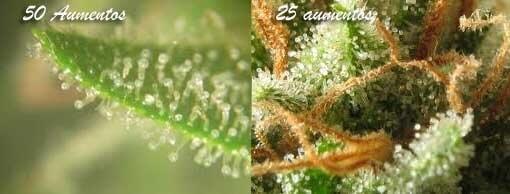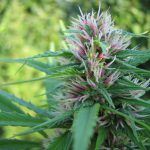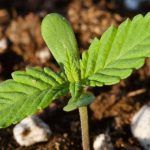THC – what is it, when and what is it produced for?
Generally, marijuana growers and users alike have a basic understanding of what THC is. Known as Tetrahydrocannabinol, this component is fundamental to Cannabis and is famously responsible for the psychoactive effects, or as it is commonly said, it is ‘the stuff that hits’. However, beyond this general knowledge, how many of us really understand what THC is, when and why marijuana produces it? In this article, we will delve into these questions to give you a deeper understanding of THC. So read on to find out more.

What is THC?
THC, whose full name is Tetrahydrocannabinol, is a naturally occurring chemical compound found mainly in the cannabis plant. This compound is famous for its psychoactive properties, i.e. it has the ability to alter the perception and mood of the user.
THC is also known by other names, such as Δ9-THC or Δ9-tetrahydrocannabinol. These names refer to the most active form of the compound, known as delta 9 THC. This is the isomer of THC found in the highest concentration in the cannabis plant and is primarily responsible for the psychoactive effects associated with its use.
Importantly, although THC is primarily known for its psychoactive effects, it also has a number of medicinal properties. It has been shown to be useful in the treatment of a variety of conditions, including chronic pain, inflammation, nausea and sleep disorders, among others. However, research in this field is still ongoing and more work is needed to fully understand the full implications of THC in medicine.
In its natural state, THC occurs as tiny crystals that cover the flowers or buds of the cannabis plant. These crystals, which at first glance may look like a kind of white resin, are actually trichomes, small glands that produce and store the active compounds in marijuana, including THC.
When heated, for example by smoking or vaporising cannabis, these THC crystals become sticky. This transformation is what allows THC to be inhaled or absorbed, which in turn leads to its famous psychoactive effects.
If you look at a marijuana bud under a microscope, you can see the true shape of the trichomes. They resemble small, semi-transparent lollipops, with a stem extending from the surface of the plant and a round head where the active compounds are concentrated.
It is in these trichomes that the magic of cannabis takes place. As the plant matures, the trichomes produce and store a variety of cannabinoids, terpenes and flavonoids, each with their own properties and effects. Among these compounds, THC is one of the most abundant and certainly the most famous, but it is far from being the only important component of this fascinating and complex plant.

One of the outstanding characteristics of THC is that it does not dissolve in liquids. It does dissolve in solvents such as ethanol or ethyl alcohol, which is used, for example, to make cannabis extractions or tincture, or in fats, which is the basis of many cannabis recipes.
It should be noted that THC is not the only active component in the cannabis plant. Another relevant compound is CBD, or cannabidiol. Although THC and CBD are both cannabinoids, they differ significantly in their effects and uses.
Unlike THC, CBD does not have a strong psychoactive effect. This means it does not produce the ‘high’ or altered perception associated with THC. Instead, CBD has more subtle, bodily effects, and has been shown to be effective in treating a variety of ailments and conditions.
For example, it has been found that CBD can help relieve chronic pain, reduce inflammation, improve sleep and alleviate symptoms of conditions such as anxiety and epilepsy. Its potential to treat more serious diseases, such as cancer and neurodegenerative diseases, is also being investigated.
Due to its great therapeutic potential and lack of strong psychoactive effects, CBD has attracted a great deal of attention in the field of medical research. More and more studies are exploring its potential uses and benefits, and it is likely that we will see more advances in this field in the coming years.
When is THC produced in the cannabis plant?
The production of THC in the cannabis plant is the result of a complex biochemical process that starts from the moment the plant germinates. This process starts with the combination of two basic compounds: olivetolic acid and geranyl pyrophosphate.
Olivetolic acid is an organic compound that occurs naturally in the cannabis plant, while geranyl pyrophosphate is a type of terpene, a class of organic compounds found in a variety of plants that are responsible for their characteristic aroma and taste.
When these two compounds combine in the cannabis plant, they initiate a series of chemical reactions that ultimately result in THC. This transformation process is catalysed by a number of enzymes, each of which plays a crucial role in the conversion of these basic compounds into THC.
This process does not occur overnight. Instead, THC production develops over the life of the plant, increasing as the plant matures and peaks during flowering.
The main cannabinoids in the cannabis plant, which include CBD (cannabidiol), THC (tetrahydrocannabinol) and CBN (cannabinol), reach their maximum concentration during the maturity of the plant’s flowers. These active chemical compounds are responsible for the various effects we experience when consuming cannabis.
The ratio of these three particular cannabinoids can vary considerably depending on the strain of cannabis and the growing conditions, and this ratio has a significant impact on the effects the plant produces.
For example, when THC is degraded, it is converted to CBN. If a cannabis plant has a high concentration of CBN, this may indicate that the THC has been greatly degraded. In these cases, the effects of consuming that plant will be more narcotic and physical, as CBN is known for its sedative properties.
On the other hand, a plant with a high ratio of THC to CBD and CBN will have a more cerebral or psychoactive effect. This is because THC is the main psychoactive compound in the cannabis plant.
These effects are subjective, or in other words, they can vary considerably between different people due to factors such as individual tolerance, the manner of use and the unique body chemistry of each individual.
What is THC good for in the plant?
Although science has not yet determined with certainty the exact function of THC in the cannabis plant, there are several theories suggesting that this compound may play a protective role. These hypotheses are based on observation of the properties of THC and how the plant behaves in different environmental conditions.
One of the most common theories is that THC acts as a form of defence against predators. Some insects and fungi can cause damage to the cannabis plant, and it is believed that THC may deter these organisms by being a toxic compound to them.
In addition, it has been suggested that THC may help the plant to withstand extreme temperature variations. Like many other plants, cannabis can suffer dehydration and damage from extreme heat or cold. THC may help protect the plant’s cells in these conditions, although more research is needed to confirm this theory.
Finally, several studies have suggested that THC may protect the plant from damage caused by ultraviolet (UV) radiation. UV light, especially UVB light, can be harmful to plants, causing DNA damage and oxidative stress. However, it has been observed that THC production in the cannabis plant increases in response to UV light exposure, suggesting that this compound may help protect the plant from this type of damage.
While the plant is young, it does not produce much THC, as it faces few threats yet. As summer approaches and flowering begins, the dangers appear, be it light, heat or insects, and Cannabis needs to protect itself.
THC and its importance in medicine and society
Over the past few decades, we have witnessed a dramatic shift in the perception of marijuana and its main component, THC. This change has been largely driven by the increasing amount of scientific research that has been conducted on cannabis and its components.
In the past, marijuana and THC were often misunderstood and stigmatised. However, as scientists have begun to discover more about what THC is and how it works, this perception has begun to change. Today, THC is recognised not only for its psychoactive effects, but also for its therapeutic potential.
Research has shown that THC can have a number of medical benefits, including relieving pain, reducing inflammation and improving appetite. These findings have led to an increase in the use of medical marijuana and have changed the way society views the plant.
In addition, THC has also played an important role in the debate about the legalisation of marijuana. As more people understand what THC is and how it can be beneficial, attitudes towards marijuana and its legalisation have changed in many parts of the world.
What is THC in medical terms?
THC, or tetrahydrocannabinol, is known for its psychoactive effects, but it also has a number of medicinal properties that make it useful in the treatment of various conditions. Some studies have shown that THC may be useful in relieving chronic pain, reducing inflammation, improving appetite and reducing nausea. Its potential to treat conditions such as multiple sclerosis and glaucoma is also being investigated.
THC and marijuana legalisation
As more people understand what THC is and how it can be beneficial, attitudes towards marijuana and its legalisation have changed in many parts of the world. More and more countries are legalising the use of marijuana for medicinal purposes and, in some cases, even for recreational use.
THC and its impact on the economy
The legalisation of marijuana has also had a significant impact on the economy. The cannabis industry, largely driven by THC, has created thousands of jobs and generated millions in tax revenue.
Understanding what THC is is fundamental to understanding the marijuana plant and its potential. As science advances and more research is conducted, we are likely to discover even more about this fascinating compound and how it can benefit society.
The amount of THC in a gram of marijuana can vary significantly depending on the strain and how the plant is grown. Marijuana can have a THC content ranging from less than 1% to around 30%. This means that one gram of marijuana could contain anywhere from less than 10 milligrams to 300 milligrams of THC. For example, if you have a strain of marijuana that has a THC content of 20%, that means there are 200 milligrams of THC in one gram of that marijuana.
The THC content of hashish can vary significantly depending on several factors, including the strain of cannabis used, the method of production and the quality of the final product. Good hashish tends to have a higher THC content than unprocessed marijuana because it is a concentrated product. The THC content in hashish can vary from around 20% to over 60%. This means that one gram of hashish could contain from 200 milligrams to over 600 milligrams of THC. However, these are only averages and the actual amount of THC can vary.
THC, or tetrahydrocannabinol, is found primarily in the Cannabis sativa plant, which includes both marijuana and hemp. It is one of many cannabinoids, or chemical compounds, present in these plants. THC is found in highest concentration in the flowers or buds. Specifically, it is produced in structures called trichomes, which are small glands on the plant that appear as shiny crystals on the surface of the flowers.
THC, or tetrahydrocannabinol, is the main psychoactive compound in the cannabis plant, meaning that it is the component that produces the “euphoric” or “high” effects associated with marijuana use. However, THC also has a number of potential medicinal and therapeutic uses.
THC for vaping refers to cannabis products that have been processed and formulated for use in a vaporiser. These products can come in various forms, including oils, waxes, and pre-filled cartridges that can be connected to a vape device. Vaping THC has some advantages over other methods of consumption. Firstly, the effects are felt almost immediately, as the THC is inhaled directly into the lungs and from there passes quickly into the bloodstream. In addition, vaping is less harmful to the lungs than smoking, as it does not involve the combustion of plant material that can release toxins and carcinogens.
How much thc is in 1 gram?
How much thc is in hashish?
Where is THC found?
What is THC good for?
THC for vaping
We hope this article has provided you with a clear and comprehensive overview of what THC is. To keep up to date with more relevant information and updates, we invite you to follow us on our social media channels and subscribe to our mailing list – we appreciate your support and look forward to continuing to be your trusted resource on THC and other marijuana-related topics! If you want to learn more about this topic, you can check out our article on marijuana harvesting.
Founder of Experiencia Natural, creative and entrepreneur, designer, master in grower and marketing. For a normalization of all plants and substances, giving priority to patients and users.














